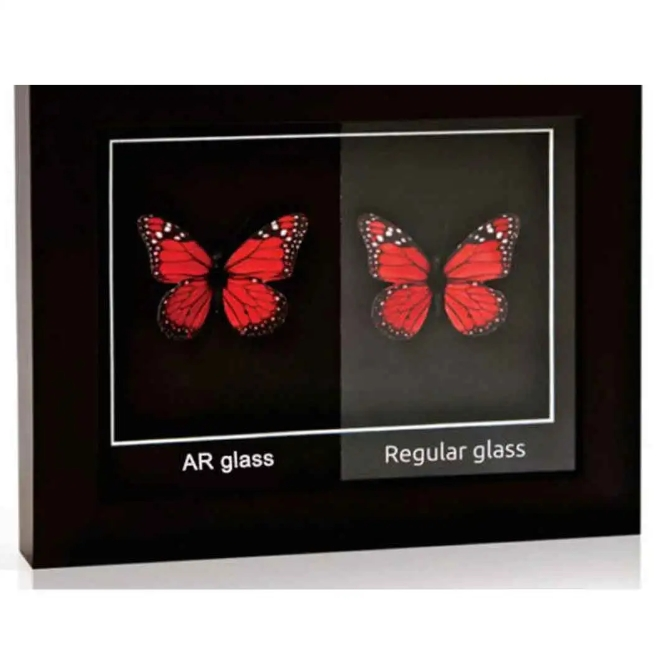
In today's visually driven world, the clarity and quality of our displays, windows, and other glass surfaces are more important than ever. Whether you're using a smartphone, watching television, driving, or admiring art, glare and reflections can be frustrating obstacles. This is where anti-reflective glass comes into play. In this article, we'll delve into what anti-reflective glass is, its principles of operation, its numerous benefits, and the wide range of applications it serves. Let's take a closer look at this transformative material, proudly offered by Evergreen Glass.

Anti-reflective glass, also known as AR glass, is a specially treated glass designed to minimize the amount of reflection seen on its surface. Standard untreated glass reflects a significant portion of light, often causing glare, reduced visibility, and even eye strain. Anti-reflective glass, on the other hand, reduces these reflections to provide a clearer, more comfortable viewing experience. This glass is particularly beneficial in environments where light conditions cannot be controlled, such as outdoors or in well-lit indoor settings.
The effectiveness of anti-reflective glass lies in its unique surface treatment. The principle involves applying a multi-layer coating to the glass surface, designed using advanced technology to reduce light reflection.
When light strikes a standard glass surface, it undergoes a phenomenon known as Fresnel reflection, which causes a portion of the light to reflect back. The anti-reflective coating comprises multiple microscopic layers with varying refractive indices. These layers are engineered to create interference patterns that cancel out the reflected light waves. This process, known as destructive interference, significantly reduces the intensity of the reflected light, leaving the glass with enhanced transparency and clarity.
Specifically, the multi-layer coating allows more light to pass through the glass and less to be reflected, tackling the double challenge of reflection and brightness loss.
Choosing anti-reflective glass comes with a plethora of benefits that enhance both aesthetics and functionality:
1. Enhanced Clarity and Brightness: With reduced reflections, AR glass allows for more light transmission, resulting in brighter and clearer displays.
2. Reduced Eye Strain: By minimizing glare, this glass provides a more comfortable viewing experience, making it less tiring on the eyes, especially during prolonged use.
3. Better Visibility in Various Conditions: Anti-reflective glass ensures consistent visibility in different lighting conditions, whether under direct sunlight or harsh indoor lighting.
4. Improved Aesthetics: The near-invisible nature of the coating makes AR glass ideal for display cases, modern architecture, and other applications where appearance is paramount.
5. High Durability: Brands like Evergreen Glass ensure that their AR coatings are durable, resistant to scratches, and designed to last.
The benefits clearly make anti-reflective glass a worthwhile investment despite its potentially higher anti reflective glass price.
Anti-reflective glass finds extensive use in various sectors due to its versatile properties. Some of the most common applications include:
1. Consumer Electronics: AR glass is widely used in smartphones, tablets, monitors, and televisions to enhance screen clarity and user experience.
2. Architectural Projects: Modern buildings employ AR glass in their facades and windows to reduce glare and improve energy efficiency while maintaining a sleek design.
3. Automotive Industry: Vehicles use anti-reflective glass in windshields and dashboard displays to improve driver visibility and safety.
4. Museum and Display Cases: Museums and exhibitions use AR glass for display cases to present artifacts and artworks without distracting reflections.
5. Optical Devices: Cameras, telescopes, and other optical equipment benefit from the enhanced light transmission of anti-reflective coatings.
6. Retail Displays: Shop windows and product displays utilize AR glass to attract customers with clearer, more attractive presentations.
7. Photography and Videography: Anti-reflective glass in lenses and filters allows for capturing clearer images and videos with reduced glare.
As technology continues to evolve, the applications of anti-reflective glass are likely to expand even further. With Evergreen Glass leading the way, consumers and industries alike can look forward to ever-improving products that push the boundaries of clarity and functionality.
Despite the potentially higher anti reflective glass price, the myriad benefits and applications of anti-reflective glass make it an essential component in today's visually-oriented world. With its advanced coating technologies and the guarantee of durability and performance from anti reflective glass company like Evergreen Glass, this innovative material stands out as a valuable investment for a wide range of uses. Whether you're looking to enhance the viewing experience on your electronic devices, improve the safety and aesthetic appeal of your vehicle, or create stunningly clear display cases, anti-reflective glass is the clear choice for superior performance and clarity.